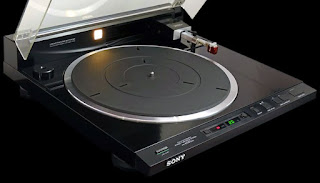Features:
Direct drive system
with BSL 9Brush and Slotless) DC servo-controlled motor
Electronically
controlled speed selection for 33-1/3 and 45 rpm with pitch control
Buil-in stroboscope
and engraved strobe markings on the platter rim
Precision machine
finished aluminium alloy platter with resonance reducing undercoating
Newly designed
record mat features air-damped record cushions
Highly sensitive
statically balanced tonearm with plug-in universal headshell
Shock-mounted static
balance counterweight with direct-reading stylus force gauge
Remote
viscous-damped cueing
Rotatable armrest
for easy tonearm balancing
Low capacitance
phono cable and separate ground wire
Removable hinged
plastic dust cover
Adjustable feet with
rubber anti-feedback isolation
Complete with 45 rpm
adapter, cartridge mounting screws and spacer
Specifications:
Turntable
Platter: 314 mm 912-3/8 inches) aluminum alloy diecast
Motor: DC brushless motor
Drive System: Direct drive
Speeds: 3-1/3 and 45 rpm
Pitch Control: ±4%
Wow and
Flutter: less than0,03% WRMS
Signal-to-Noise
Ratio: better than 70 dB (DIN-B)
Tonearm
Type: Statically balanced, universal
Pivot to Stylus
Length: 216,5 mm 98-1/2 inches)
Overall Arm
length: 300 mm 911-7/8 inches)
Overhang: 16,5 mm (21/32 inchees)
Tracking Error: within +3°, -1°
Tracking Force
Adjustment Range: 0- 3 g
Shell Weight: 7,5 g
Cartridge Weight
Range: 4 - 13 g (without extra weight)
General
Power
Requirements: 120 V, 60 Hz
Power Consumption:
10 W
Dimensions (W x H x
D): 445 x 155 x 365 mm (17-5/8" x
6-1/8" x 14-3/8")
Weight (net): 9 kg ( 19 lb 13 oz)





























